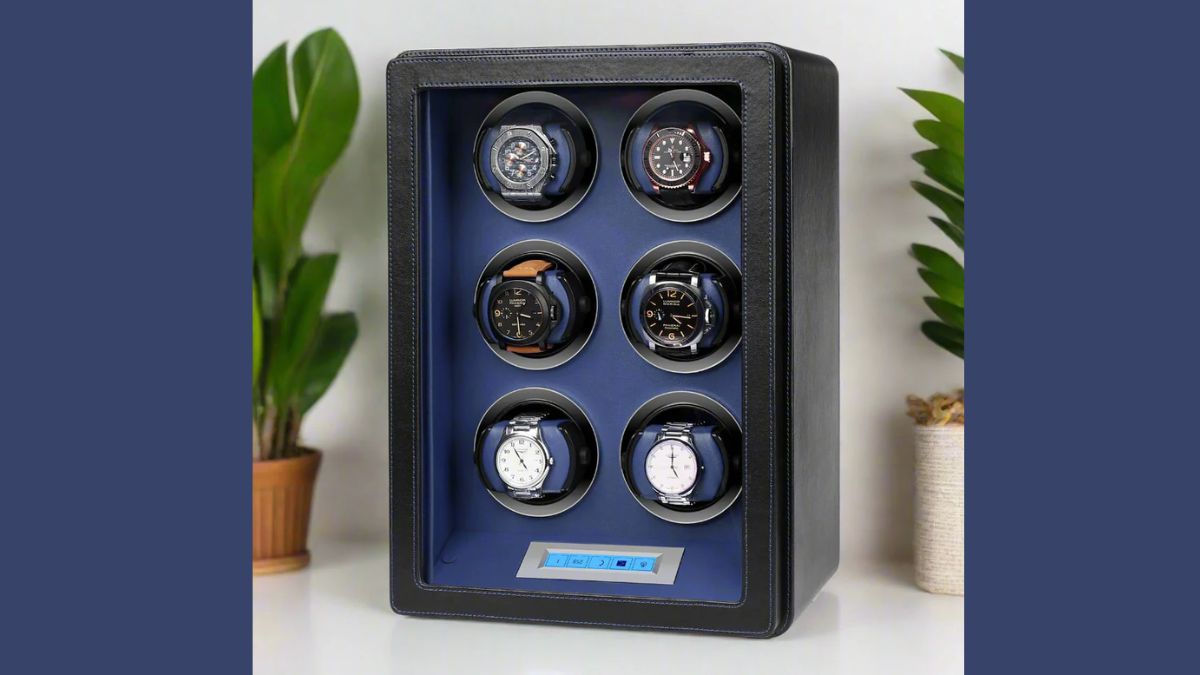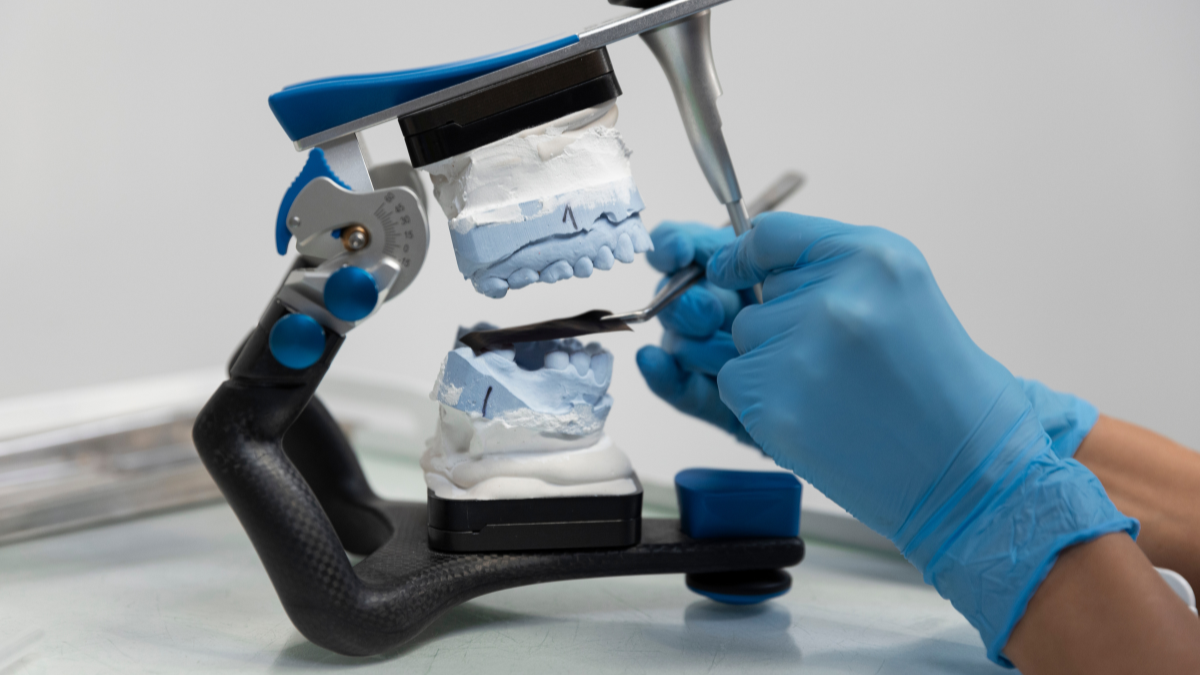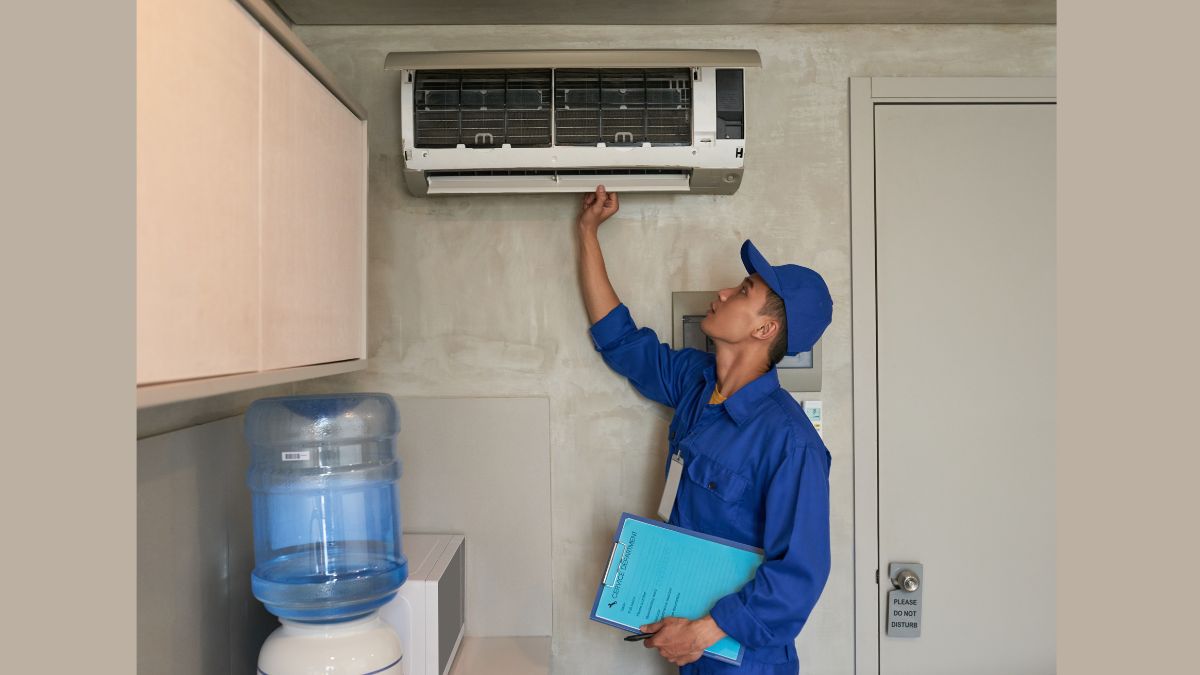TECHNOLOGY
Understanding Watch Auto Winders: A Comprehensive Guide

Automatic watches are prized for their intricate mechanics and timeless elegance. However, for enthusiasts and collectors alike, maintaining these watches in peak condition can be challenging. One solution is the watch auto winder, a device designed to keep automatic watches running smoothly when not worn regularly. In this article, we delve deep into the world of watch auto winders, exploring their function, benefits, and how to choose the best one for your needs.
What is a Watch autowinder?
A watch auto winder is an electromechanical device that keeps automatic watches ticking by mimicking the natural motion of the wrist. When a watch is worn, the movement of the arm causes a rotor inside the watch to swing, generating energy that winds the mainspring. Over time, if a watch is left unworn, it stops running. An auto winder replicates this motion, ensuring that the watch remains powered and displays the correct time.
Key Functions of an Auto Winder
- Simulating Wrist Movements: The auto winder rotates the watch in various directions to simulate the movement of a wrist.
- Maintaining power reserve: By continually winding the watch, it ensures that the power reserve is maintained.
- Preserving Accuracy: Keeping the watch running helps maintain its accuracy and reduces the need for manual winding.
How Do Automatic Watches Work?
To appreciate the value of a watch auto winder, it’s important to understand how automatic watches operate. Automatic watches use the natural motion of the wearer’s wrist to wind the mainspring. This stored energy is then released gradually to power the watch’s time keeping functions.
The Role of the Rotor
The rotor is a semi-circular weight that swings freely with every movement. Its motion is directly linked to the winding mechanism:
- Energy Generation: As the rotor moves, it transfers kinetic energy to the mainspring.
- Efficiency: The design of the rotor ensures that even minimal movement can result in sufficient winding, making automatic watches efficient timepieces.
- Continuous Operation: When placed on an auto winder, the rotor is set into continuous motion, ensuring that the watch always has enough power to function properly.
Energy Storage and the Mainspring
The mainspring is the heart of any mechanical watch. It stores energy generated by the rotor and releases it gradually:
- Power Reserve: The duration a watch can run on a fully wound mainspring varies, but most automatic watches have a power reserve ranging from 40 to 80 hours.
- Consistent Functionality: With a properly maintained power reserve, the watch remains consistent in timekeeping, even when not worn daily.
Benefits of Using a Watch Auto Winder
Watch auto winders offer several advantages, making them indispensable for watch collectors and enthusiasts. Here are some of the primary benefits:
Convenience and Time Savings
For those who own multiple automatic watches, winding each watch manually can be tedious. Auto winders:
- Automate the Process: They eliminate the need for daily winding.
- Ensure Readiness: Watches remain ready to wear at any time, providing peace of mind for collectors.
Maintaining Watch Accuracy
A continuously running watch tends to be more accurate:
- Consistent Movement: Regular winding ensures that the mechanical parts are always active.
- Reduced Wear and Tear: Keeping the watch in motion prevents lubrication from settling or thickening, which can impact accuracy.
Longevity of Your Timepieces
By maintaining an optimal power reserve and reducing the manual winding process, auto winders contribute to the longevity of automatic watches:
- Even Distribution of Wear: The constant movement prevents the build-up of mechanical strain.
- Preservation of Value: For collectors, keeping watches in pristine condition is crucial, and auto winders play a vital role in that maintenance.
Enhancing Aesthetic and Display
Auto winders also serve as attractive display pieces:
- Elegant Design: many auto winders are designed to be visually appealing, making them ideal for showcasing a watch collection.
- Versatile Options: Available in various styles and finishes, they can complement any décor, from modern to classic.
Comparison of Key Benefits
Below is a table summarizing the key benefits of using a watch auto winder:
| Feature | Description | Benefit |
| Convenience | Automates the winding process. | saves time and ensures the watch is always ready. |
| Accuracy | maintain consistent movement of the watch’s mechanism. | Enhances timekeeping precision and reliability. |
| Longevity | Prevent uneven wear and maintains lubrication. | extends the lifespan of the watch. |
| Aesthetic Appeal | Often designed as an elegant display piece. | Enhances the visual presentation of a collection. |
| Power Reserve | Keeps the mainspring continuously wound. | Ensures optimal performance even after periods of inactivity. |
Factors to Consider When Choosing a Watch Auto Winder
Selecting the right auto winder involves understanding several technical and design considerations. Below are key factors to evaluate before making a purchase.
Winding Direction and Intervals
Different automatic watches have unique winding requirements:
- Unidirectional vs. Bidirectional: Some watches require movement in one direction only, while others can be wound from multiple angles.
- Adjustable Intervals: Look for models that allow you to set winding intervals and rotations per day to match the watch’s specifications.
Capacity and Compatibility
Auto winders come in various sizes and configurations:
- Single vs. Multiple Watch Holders: Depending on the size of your collection, you may need a device that accommodates more than one watch.
- Universal Compatibility: Ensure that the auto winder is suitable for different watch sizes and movement types.
Noise Level and Operation
The operational noise of an auto winder can be a concern, especially if placed in quiet environments:
- Quiet Motors: Choose models with low decibel levels to minimize disturbance.
- Smooth Operation: A smooth, consistent winding mechanism reduces the risk of jostling or damaging the watch.
Build Quality and Materials
The durability and aesthetics of an auto winder depend heavily on its construction:
- Premium Materials: Look for devices made from high-quality wood, metal, or acrylic that not only provide a robust build but also offer an elegant look.
- Craftsmanship: Detailed craftsmanship ensures the device will last, offering both functional and aesthetic value.
Design and Display
Since an auto winder often doubles as a display piece, its design is important:
- Modern vs. Classic: Choose a design that complements your style and the setting where it will be placed.
- Customization: Some models offer customizable options like adjustable compartments, lighting, or rotation settings.
Maintenance and Usage Tips for Watch Auto Winders
Proper maintenance of a watch auto winder ensures longevity and optimal performance. Here are several tips to get the most out of your device:
Proper Setup and Installation
- Stable Surface: Place your auto winder on a level, stable surface to prevent unwanted vibrations.
- Secure Placement: Ensure that the watch fits securely within the winder’s holder to avoid accidental falls or damage.
- User Manual: Always refer to the manufacturer’s guidelines for setup instructions, even though specific brand names are not mentioned here.
Regular Cleaning and Dust Prevention
Keeping the device clean is essential for long-term performance:
- Dusting: Use a soft, dry cloth to regularly remove dust and debris from the winder’s surface.
- Avoid Moisture: Do not use water or cleaning agents that might damage the mechanism or finish.
Monitoring the Power Reserve
Understanding the power reserve of your automatic watch is key:
- Observation: Regularly check that the watch maintains its power reserve, especially if it is not worn daily.
- Adjustment: If you notice any irregularities in the watch’s performance, consider adjusting the winding intervals on your auto winder.
Troubleshooting Common Issues
Even with regular maintenance, you might encounter issues:
- Inconsistent Winding: Ensure that the watch is correctly positioned and that the winder settings match the watch’s requirements.
- Motor Noise: If the motor becomes louder over time, it may indicate wear or the need for professional servicing.
The Science Behind Watch Auto Winders
For enthusiasts with a keen interest in horology, understanding the engineering behind watch auto winders adds another layer of appreciation.
Mechanical Engineering of Auto Winders
At its core, a watch auto winder is a marvel of mechanical engineering:
- Electric Motors: These provide the rotational energy required to simulate natural wrist movement.
- Gearing Systems: The intricate gearing ensures that the rotation mimics natural motion patterns accurately.
- Precision Control: Modern auto winders often incorporate microcontrollers that allow for precise adjustments in rotation speed and interval timing.
Energy Efficiency and Conservation
Auto winders are designed to be energy efficient:
- Low Power Consumption: Despite their continuous operation, many models are engineered to consume minimal energy.
- Sustainable Operation: Some devices include energy-saving modes that activate when the watch’s power reserve is full, reducing unnecessary energy usage.
Technological Innovations
Recent advancements have enhanced the functionality and design of auto winders:
- Programmable Settings: Users can program specific winding sequences tailored to their watches.
- Enhanced Durability: Improvements in motor technology and material science have resulted in more durable, long-lasting devices.
- User-Friendly Interfaces: Modern auto winders often come with digital displays or remote control options for ease of use.
Additional Insights: Enhancing Your Watch Collection
For many watch enthusiasts, the auto winder is more than just a functional device—it is a part of a broader lifestyle centered on the appreciation of fine mechanical craftsmanship.
Display and Collection Management
- Showcase Your Collection: Auto winders serve as both functional devices and elegant display cases. They provide a sophisticated way to showcase your prized timepieces.
- Organized Storage: Some auto winders come with compartments or multiple holders, allowing for an organized display of a collection.
- Aesthetic Integration: Consider the decor of the room where the auto winder will be placed. An auto winder with a refined design can enhance the overall ambiance of your space.
The Role of Auto Winders in Investment
For collectors who view watches as investments, preserving the condition of each timepiece is paramount:
- Maintaining Market Value: A well-maintained watch that runs regularly is more likely to retain its value over time.
- Preventing Mechanical Failures: Continuous motion keeps the internal components in optimal condition, reducing the risk of costly repairs.
- Historical Preservation: For vintage watches, using an auto winder can help in preserving the historical integrity and mechanical precision of the piece.
A Closer Look at the Design Elements
The design and craftsmanship of watch auto winders often mirror the artistry found in the watches they serve. Here, we explore some design elements that add to their appeal.
Materials and Finishes
Auto winders are crafted using a variety of materials, each contributing to the overall quality:
- Wood: Offers a classic, timeless appeal and is often chosen for its rich, natural aesthetics.
- Metal: Provides durability and a sleek, modern look. Metal winders are particularly favored in contemporary settings.
- Acrylic/Glass: Often used in combination with other materials, these finishes add a touch of elegance and allow for visual monitoring of the watch’s movement.
Customizable Features
Modern auto winders often allow for a degree of customization:
- Interchangeable Covers: Some models offer interchangeable covers or panels that can be switched to match the décor.
- Lighting Options: Integrated LED lighting not only enhances the display but also makes it easier to view your watch collection in low-light conditions.
- Programmable Sequences: Customizable winding sequences ensure that each watch receives the precise motion it needs, reflecting the attention to detail found in fine watchmaking.
Practical Tips for Maximizing the Benefits of Your Auto Winder
To fully enjoy the benefits of a watch auto winder, consider the following practical tips:
Setting Up Your Auto Winder
- Read the Manual: Even though the article avoids mentioning specific brands, always follow the setup guidelines provided by the manufacturer.
- Test Different Modes: Experiment with various winding modes and intervals to find the optimal settings for each watch in your collection.
- Monitor Performance: Keep an eye on the watch’s performance after setting up the auto winder. This will help you detect any issues early and make necessary adjustments.
Integrating with Your Daily Routine
- Central Location: Place the auto winder in a central location where it is both accessible and visible, reinforcing the connection between your timepieces and your daily life.
- Regular Checks: Incorporate a routine check of your auto winder’s operation into your regular watch maintenance schedule.
- Combine with Other Accessories: Consider pairing your auto winder with a watch case or display cabinet to create a comprehensive storage and display solution.
- Troubleshooting and Long-Term Care
- Identify Abnormalities: If the auto winder’s operation seems irregular—such as inconsistent rotation or unusual noise—investigate the issue promptly.
- Professional Servicing: For any persistent problems, consulting a professional watchmaker or technician is advisable. They can offer insights on adjusting the device or servicing its motor and gears.
- Firmware Updates: For auto winders that come with digital interfaces, periodically check for firmware updates that may improve functionality and energy efficiency.
Conclusion
Watch auto winders have become an essential tool for anyone serious about maintaining their automatic watch collection. They bridge the gap between functionality and aesthetics, ensuring that your timepieces remain in pristine condition while also serving as a sophisticated display piece. From the engineering behind the winding mechanisms to the practical considerations of everyday use, these devices offer an array of benefits that enhance the longevity and performance of automatic watches.
Whether you are a seasoned collector or a newcomer to the world of mechanical watches, investing in a reliable auto winder can transform how you manage and enjoy your collection. By ensuring that your watches are always ready to wear and remain accurate, a well-chosen auto winder not only preserves the mechanical integrity of your timepieces but also underscores your passion for horology.
FAQs
1: Do I Really Need a Watch Auto Winder?
If you own one or more automatic watches that are not worn daily, a watch auto winder can be a valuable investment. It ensures that your watches remain wound and ready to wear at any moment, preserving their functionality and accuracy.
2: Can Using an Auto Winder Damage My Watch?
When used properly and set to the correct intervals, a watch auto winder should not damage your watch. In fact, by preventing the lubricants within the watch from settling or thickening, auto winders can help maintain optimal performance.
3: How Do I Adjust the Settings on My Auto Winder?
Many modern auto winders feature adjustable settings for rotation direction, speed, and intervals. Consult your device’s manual for specific instructions, and experiment with different settings to find the best match for your watch’s needs.
4: Are Auto Winders Suitable for All Automatic Watches?
Most automatic watches can benefit from an auto winder, but it is important to check your watch’s manual or consult with a watchmaker to determine the ideal winding settings, especially if the watch has unique specifications or complications.
5: How Often Should I Clean My Auto Winder?
Regular maintenance is key. Dust your auto winder at least once a month and clean it thoroughly every few months, depending on the environmental conditions.
TECHNOLOGY
The Evolution of Dental Crowns: A Journey Through Technological Progress

Dental crowns have long been a cornerstone of restorative dentistry. Used to repair and protect damaged teeth, crowns restore not only functionality but also appearance. Traditionally, patients had to endure long waits, multiple appointments, and uncomfortable impressions. Today, however, advanced tools like CEREC technology have transformed this process. The evolution of dental crowns has been a journey from manual craftsmanship to high-tech precision — making the patient experience faster, more comfortable, and more reliable than ever.
The Traditional Approach: Artistry and Time
In the past, the process of getting dental crowns could span several weeks. Dentists would begin with a physical impression of the tooth using a tray filled with putty-like material. This step often triggered discomfort or even a gag reflex in patients. Afterward, the mold would be sent to a dental lab where a skilled technician would craft the crown by hand — a meticulous and time-consuming process. Once the crown was ready, patients had to return for a second visit to have it fitted and cemented. If the fit or color wasn’t perfect, further adjustments or even a remake were needed, extending the treatment time. Although the final results were often effective, the process was labor-intensive and left room for human error.
A Digital Revolution: CAD/CAM and Beyond
The first significant leap in dental crowns came with the introduction of CAD/CAM (Computer-Aided Design/Computer-Aided Manufacturing) systems. This technology brought computer precision into the dental world. Digital scanners began to replace traditional impression materials, allowing for more accurate imaging of a patient’s teeth. CAD/CAM software could then design a virtual model of the crown, which could be milled from ceramic blocks by computer-guided machines. This greatly improved both the speed and precision of crown production. Although initially limited to dental laboratories, this technology laid the groundwork for in-clinic innovation — most notably, the advent of CEREC technology.
CEREC Technology: A Game-Changer
Short for Chairside Economical Restoration of Esthetic Ceramics, CEREC technology has redefined the crown-making process. With CEREC, patients can now receive custom-made dental crowns in a single visit — often within just a couple of hours. Here’s how it works:
- Digital Imaging: A small camera scans the affected tooth, creating a highly accurate 3D model — eliminating the need for messy impressions.
- Design Software: The dentist uses CEREC’s software to design the crown on-screen, ensuring perfect shape, bite alignment, and aesthetics.
- In-House Milling: A milling unit located right in the dental office carves the crown from a ceramic block based on the design.
- Immediate Placement: After some finishing touches and color adjustments, the crown is polished, bonded, and fitted — all in one visit.
The entire process is streamlined, efficient, and much more comfortable for the patient.
Benefits of Modern Crown Technology
Thanks to innovations like CEREC technology, the experience of getting dental crowns is more patient-friendly and efficient. Some key benefits include:
- Time Savings: Single-visit crowns eliminate the need for temporary restorations and follow-up appointments.
- Accuracy: Digital impressions are more precise, reducing the risk of ill-fitting crowns and the need for remakes.
- Comfort: No more goopy molds or temporary crowns that can fall off or irritate gums.
- Aesthetics: Ceramic materials closely mimic the natural appearance of teeth, and color can be customized chairside.
- Durability: CEREC crowns are strong and long-lasting, capable of withstanding normal biting and chewing forces.
The Role of Artificial Intelligence and Future Developments
Beyond CEREC, the next wave of technology in dental crowns involves artificial intelligence (AI) and machine learning. AI-driven systems can now help detect decay, suggest optimal crown designs, and even predict long-term outcomes. Integration with intraoral scanners and cloud-based platforms allows dentists to collaborate seamlessly with labs and specialists across the globe. In the near future, we may also see biocompatible materials that better integrate with natural tissues, or even smart crowns embedded with sensors to monitor bite pressure and oral health in real time.
A New Era of Dental Restoration
The journey of dental crowns — from hand-crafted restorations to computer-designed masterpieces — is a testament to how far dentistry has come. What was once a multi-week ordeal is now a same-day, high-precision solution, thanks in large part to CEREC technology. This evolution not only enhances clinical efficiency but also transforms the patient experience. In a world where time and comfort matter more than ever, modern crown technologies offer a blend of convenience, function, and aesthetics that was unimaginable just a few decades ago. As dental technology continues to evolve, so too will the possibilities for restorative care — making smiles healthier, faster, and more beautiful with each innovation.
TECHNOLOGY
What Are the Signs You Need AC Repair Services in Maryland?

As Maryland’s summer heat intensifies, a well-functioning air conditioning system becomes essential for maintaining indoor comfort. However, even the most reliable AC units can develop issues over time. Recognizing the early signs of malfunction can prevent costly repairs and ensure uninterrupted cooling. Below are the key indicators that suggest the need for AC repair services in Maryland.
Signs for AC Repair Services in Maryland
1. Weak Airflow and Insufficient Cooling
One of the most common signs of AC trouble is weak airflow. If your system struggles to circulate cool air effectively, it may be due to clogged air filters, a failing compressor, or ductwork obstructions. Homeowners in Maryland should address this issue promptly to avoid discomfort during peak summer months.
2. Unusual Noises During Operation
A properly functioning AC unit operates quietly. If you hear grinding, squealing, or banging sounds, it could indicate loose components, a worn-out belt, or motor failure. Ignoring these noises may lead to more extensive damage, requiring emergency AC repair in Maryland.
3. Unpleasant Odors from Vents
Foul smells emanating from your air conditioning system can signal mold growth, burnt wiring, or trapped moisture. Musty odors often indicate biological contamination, which is common in Maryland’s humid climate. A professional air conditioning repair service in Maryland can diagnose and resolve these issues effectively.
4. Increased Energy Bills Without Increased Usage
A sudden spike in electricity bills without a change in usage patterns suggests inefficiency in your AC system. This could be due to failing components, restricted airflow, or refrigerant leaks. Addressing these concerns early can prevent excessive energy consumption and reduce costs.
5. Frequent Cycling or Constant Running
If your AC unit cycles on and off frequently or runs continuously without achieving the desired temperature, it may be struggling with thermostat issues, low refrigerant levels, or dirty coils. These problems can lead to premature wear and tear, necessitating AC repair in Maryland.
Table 1: Common AC Issues and Their Causes
| Issue | Possible Cause |
| Weak airflow | Clogged filters, duct obstructions |
| Unusual noises | Loose components, failing motor |
| Bad odors | Mold growth, burnt wiring |
| High energy bills | Inefficient cooling, refrigerant leaks |
| Constant running | Thermostat malfunction, dirty coils |
6. Thermostat Malfunctions
A faulty thermostat can cause inconsistent cooling, leading to discomfort and inefficiency. If your AC fails to maintain the set temperature, recalibrating or replacing the thermostat may be necessary.
7. Moisture or Leakage Around the Unit
Excess moisture or refrigerant leaks around the AC unit indicate potential system failure. Refrigerant leaks can compromise cooling efficiency, while water accumulation may lead to mold growth and structural damage.
8. Delayed Response to Temperature Adjustments
If your AC takes longer than usual to respond to thermostat changes, it may be experiencing electrical or sensor issues. A timely AC repair service in Maryland can restore optimal performance.
Table 2: Signs That Require Immediate AC Repair
| Sign | Urgency Level |
| Loud noises | High |
| Refrigerant leaks | High |
| Weak airflow | Medium |
| Increased energy bills | Medium |
| Thermostat issues | Low |
Conclusion
Recognizing the early signs of AC trouble is crucial to ensuring your comfort during Maryland’s hot summer months. Whether it’s weak airflow, unusual noises, or increased energy bills, addressing these issues promptly can prevent costly repairs and keep your system running smoothly. If you’re experiencing any of these signs, don’t hesitate to contact First Response Heating & Cooling for reliable and efficient AC repair services in Maryland. Our team is here to restore your home’s comfort with expert solutions tailored to your needs.
TECHNOLOGY
Why Is Your AC Not Cooling? Call for Expert Repair in San Marcos

As temperatures rise in San Marcos, the last thing you want is for your air conditioning (AC) system to stop cooling effectively. If you’re finding that your AC isn’t cooling as it should, it could be a sign of a serious issue. It’s essential to address these problems as soon as possible to avoid further complications and ensure the comfort of your home. In this blog, we’ll explore common reasons why your AC may not be cooling and the expert AC repair services in San Marcos that can help restore it.
Common Causes of AC Cooling Issues
Before calling in an expert, it’s important to understand the potential causes of your AC’s cooling problems. Let’s take a look at some common issues that could be affecting your AC’s performance.
1.Clogged Air Filter
A clogged air filter is one of the most common reasons for reduced cooling efficiency in AC systems. Air filters trap dust, dirt, and debris, preventing them from entering the AC unit. However, when the filter becomes too clogged, it can restrict airflow. This reduces the system’s ability to cool air properly, leading to warm air circulating in your home.
Solution: Replace the air filter regularly, ideally every 1-3 months, to ensure proper airflow and prevent the system from overworking.
2.Low Refrigerant Levels
Refrigerant is the fluid that absorbs and expels heat from your home. If your AC is low on refrigerant, it will struggle to cool the air. A drop in refrigerant levels is often caused by a leak somewhere in the system. If the leak isn’t repaired, your AC will continue to lose refrigerant, making it unable to cool effectively.
Solution: If you suspect low refrigerant, it’s crucial to call a professional for a leak detection and refrigerant recharge. Only a certified technician should handle refrigerant, as it requires special tools and knowledge.
3 Frozen Evaporator Coil
The evaporator coil is responsible for absorbing heat from the air in your home. If the coil freezes, it prevents the system from cooling properly. This can happen if there is restricted airflow due to a clogged filter or dirty coils. It can also happen if your AC is low on refrigerant.
Solution: To prevent the coils from freezing, ensure that your system is well-maintained with clean air filters and proper refrigerant levels. If the coils are already frozen, the system should be turned off to allow them to thaw before further inspection.
4. Dirty Condenser Coils
The condenser coil releases the heat absorbed by the refrigerant. If the condenser coils are dirty, they won’t be able to release heat effectively. This can cause the AC system to overheat and struggle to cool your home.
Solution: Cleaning the condenser coils regularly is essential for maintaining efficient cooling. A professional can clean these coils thoroughly to restore proper cooling performance.
5 Faulty Thermostat
The thermostat is responsible for regulating the temperature in your home. If the thermostat is faulty or malfunctioning, it may not accurately detect the temperature or communicate with the AC unit to turn on and off at the right times.
Solution: Check the thermostat’s settings and replace its batteries if necessary. If it still malfunctions, it might need to be recalibrated or replaced by an expert technician.
6 Electrical Issues
Electrical problems, such as a malfunctioning capacitor or contactor, can prevent your AC from operating properly. These components are responsible for powering the unit and controlling various operations. If they are faulty, your AC may not be able to run or cool effectively.
Solution: Electrical issues require immediate attention. A licensed technician can inspect and repair any electrical components to ensure the AC operates smoothly.
7.Blocked Ducts
If your home’s ducts are blocked or leaking, cool air may not be able to circulate properly throughout the space. This can lead to uneven cooling, with some rooms staying warmer than others.
Solution: Having your ducts cleaned and inspected can ensure that air is flowing freely through your system. This is especially important if you’ve noticed warm spots in your home or inconsistent cooling.
8.Compressor Problems
The compressor is the heart of your AC system. It pumps refrigerant through the system and ensures that the heat exchange process works. If the compressor fails, your AC will not be able to cool the air effectively, and it may even stop working entirely.
Solution: Compressor issues are often complex and require professional repair. If the compressor is damaged, it may need to be replaced.
Signs Your AC Needs Professional Repair
It’s easy to ignore small problems with your AC, but early intervention can prevent larger, more expensive repairs. Here are some signs that your AC needs professional attention:
- Warm Air Coming from Vents: If the air coming from your AC vents is warm, there’s a serious problem with your cooling system. It could be due to low refrigerant, a dirty coil, or a malfunctioning compressor. A technician will need to diagnose the root cause.
- Loud Noises from the Unit: Unusual noises like grinding, rattling, or buzzing can indicate problems with the motor or other components. These noises should never be ignored, as they often signal mechanical issues that need immediate attention.
- Water Leaks Around the Unit: Water pooling around your AC unit can indicate a clogged condensate drain, a refrigerant leak, or other issues. If the problem is ignored, it could lead to water damage in your home or further damage to the AC unit.
- Inconsistent Temperatures: If certain rooms are cooler than others, your AC may not be distributing air evenly. This could be due to ductwork issues, a malfunctioning thermostat, or an imbalance in the system.
- Increased Energy Bills: If your energy bills are higher than usual without any increase in usage, your AC system may be working harder than it should to cool your home. This can indicate a problem with the unit that’s affecting its efficiency.
Conclusion
If your AC isn’t cooling properly, don’t wait to call for expert repair services in San Marcos. Whether it’s a clogged filter, low refrigerant, or a mechanical failure, a qualified technician can restore your AC’s performance and keep your home cool all summer long. At Woods Comfort Systems, we’re here to provide reliable and efficient AC repair services, so you don’t have to suffer through the heat.
-

 BLOG5 months ago
BLOG5 months agoSlothokiturbo.net: Exploring the World of Online Gaming and Community
-

 BLOG2 months ago
BLOG2 months agoLiteroticatags: Exploring the World of Erotica and Its Online Community
-

 TECH6 months ago
TECH6 months agoMansrufer: Pioneering Progress in Technology
-

 BLOG5 months ago
BLOG5 months agoUse 1.5f8-p1uzt – A Comprehensive Guide!
-

 BLOG6 months ago
BLOG6 months agoErothtos: Understanding Its Role in Today’s World 2025
-

 BLOG6 months ago
BLOG6 months agoWatchmenontheall Calvin: An Exploration of Themes, Characters, and Significance
-

 TECH6 months ago
TECH6 months agoEggFinder TX Rev C5: A Comprehensive Review and Guide
-

 BLOG2 months ago
BLOG2 months agoJonathonSpire: We Learn About Her Career
